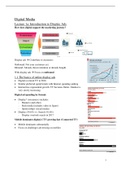Class notes
Class notes Digital Media 328064-M-6
- Course
- Institution
Class Notes of the course Digital Media from the master Marketing Management Tilburg University. This provides a summary of all the lectures and more information written during the lectures of this course. Hope this helps you study for the exam. Good luck!
[Show more]



